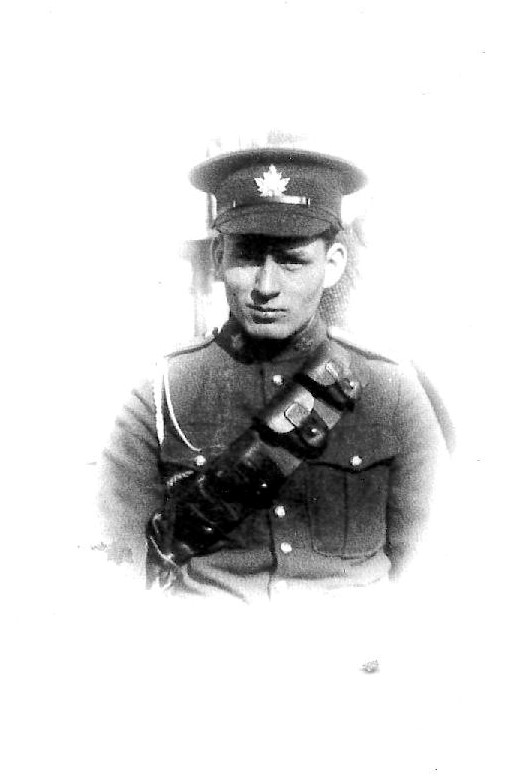Pte
Frank Angus McKinnon
Informations sur naissance
|
Date de naissance: 28/01/1898 |
|
Lieu de naissance: Brantford, Ontario, Canada |
Informations générales
|
Dernière résidence connue: 70 Main Street West, Hamilton, Ontario, Canada |
|
Profession: Machinist |
Informations service militaire
|
Pays: Canada |
|
Force armée: Canadian Expeditionary Force |
|
Rang: Private |
|
Numéro de service: 225401 |
|
Incorporation date: 20/02/1917 |
|
Incorporation nom de lieu: Hamilton, Ontario, Canada |
|
Unités: — Canadian Infantry, 102nd Bn. (Central Ontario) (Dernière unité connue) |
Informations sur décès
|
Date de décès: 18/11/1917 |
|
Lieu de décès: Mosselmarkt, Passchendaele, Belgique |
|
Cause du décès: Killed in action (K.I.A.) |
|
Âge: 19 |
Mémorial
|
Ypres (Menin Gate) Memorial Panneau: 30T |
Distinctions et médailles 2
|
British War Medal Médaille |
|
Victory Medal Médaille |
Points d'intérêt 4
| #1 | Lieu de naissance | ||
| #2 | Dernière résidence connue | ||
| #3 | Lieu d'enrôlement | ||
| #4 | Lieu du décès (approximatif) |
Mon histoire
Private Frank Angus McKinnon served in the 102nd Battalion (Central Ontario) of the Canadian Infantry, part of the 11th Brigade, of the 4th Canadian Division. Frank joined the army in February 1917 when he was 19-years-old. At the time he was working as a machinist in Brantford, Ontario.
The Battle of Passchendaele (or Third Battle of Ypres) had started on July 31st,1917 and it had taken the Allies more than 98 days and 250,000 casualties to reach the village and the dubious honour of taking it had fallen to the Canadians. The capture of Passchendaele started with a successful Canadian assault on the shattered remains of the village on 6 November 1917. Fighting was often hand-to-hand as the Germans tried desperately to hang on. The 31st and 28th Battalion had also succeeded to capture the area of Passchendaele Ridge just north of the village.
They were now firmly established on top of Passchendaele Ridge. However, the Germans were still clinging to the slopes east of the village. On November 10th, the final Canadian attack was launched to secure their hard-won position on the Ridge.
They drove the Germans eastward on to the flat plain below. The view of rolling, green countryside to the east must have seemed like heaven to the advancing Canadian troops, for the view westward, towards Ypres, was that of hell. The Canadians held the line at Passchendaele until November 18th when they were withdrawn to the Vimy-Lens sector. It was their last visit to the immortal Ypres Salient.
In the War Diaries of the 102nd Battalion we can read: “Heavy enemy firing all morning. Lieut. A.R. Turner being wounded, 4 other ranks being killed and 6 wounded. Relief by the Suffolks commenced at 5 p.m.”. Frank Angus McKinnon, aged 19, was one of the 4 soldiers killed:” While in the front line trenches, he was hit in the head and instantly killed by a German shell.” Frank was initially buried in the Hamlet of Mosselmarkt, just north of Passchendaele. But his grave might have got lost in the further fighting or his remains weren’t positively identified after the War. With no known grave, his name is commemorated on the Ypres (Menin Gate) Memorial, bay 30 panel T.
The Battle of Passchendaele (or Third Battle of Ypres) had started on July 31st,1917 and it had taken the Allies more than 98 days and 250,000 casualties to reach the village and the dubious honour of taking it had fallen to the Canadians. The capture of Passchendaele started with a successful Canadian assault on the shattered remains of the village on 6 November 1917. Fighting was often hand-to-hand as the Germans tried desperately to hang on. The 31st and 28th Battalion had also succeeded to capture the area of Passchendaele Ridge just north of the village.
They were now firmly established on top of Passchendaele Ridge. However, the Germans were still clinging to the slopes east of the village. On November 10th, the final Canadian attack was launched to secure their hard-won position on the Ridge.
They drove the Germans eastward on to the flat plain below. The view of rolling, green countryside to the east must have seemed like heaven to the advancing Canadian troops, for the view westward, towards Ypres, was that of hell. The Canadians held the line at Passchendaele until November 18th when they were withdrawn to the Vimy-Lens sector. It was their last visit to the immortal Ypres Salient.
In the War Diaries of the 102nd Battalion we can read: “Heavy enemy firing all morning. Lieut. A.R. Turner being wounded, 4 other ranks being killed and 6 wounded. Relief by the Suffolks commenced at 5 p.m.”. Frank Angus McKinnon, aged 19, was one of the 4 soldiers killed:” While in the front line trenches, he was hit in the head and instantly killed by a German shell.” Frank was initially buried in the Hamlet of Mosselmarkt, just north of Passchendaele. But his grave might have got lost in the further fighting or his remains weren’t positively identified after the War. With no known grave, his name is commemorated on the Ypres (Menin Gate) Memorial, bay 30 panel T.
